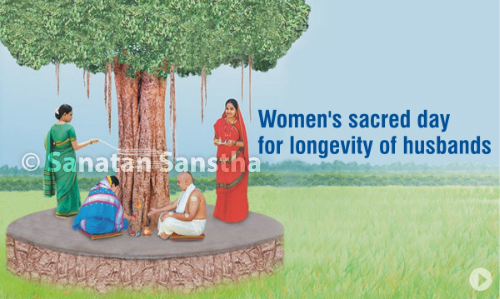
Contents
1. Introduction
Vatasavitri is a vowed religious observance performed by married women on the full moon day (pournima) of Jyeshtha to prolong their wifehood. Lord Brahma along with Savitri is the main deity while Satyavan, Savitri, Narad and Yamraj are the subordinate deities this vowed religious observance. Among the famous, chaste women (pativratas) in India, Savitri is considered the ideal. She is also considered the symbol of eternal wifehood.
The story of Sati Savitri has been mentioned in the Mahabharat. While the Pandavas were in exile, Jayadratha abducted Draupadi. After the Pandavs freed her and returned, they were all sitting with some sages. At that time Sage Markandeya narrated story of Savitri. The importance of Savitri can be understood now as her story was told to Draupadi, who is included among the five great women of virtue of India.
1.1 Choosing Satyawan
Once, Devarshi Narad came to King Ashwapati’s court. He was felicitated by the king and they started conversing. Soon after that, the king’s daughter Savitri came in. She greeted her father and Sage Narad. On seeing her Sage Narad asked as to why she was still unmarried? To this the king answered that Savitri had been sent to find and chose her own husband. During this there had been an incident. On being asked Savitri narrated the story. She said, “Once there was a famous and righteous king named Dyumatsen in Shalvadesh (the name of his kingdom) who became blind. When that happened, his son was still quite young. Thus, a neighbouring king attacked and took over his kingdom. The king, along with his queen and son went to the forest and started leading an ascetic life.
His son is a handsome and kind young man now. I feel that he is ideal and so I have mentally accepted him as my husband.” Upon hearing Satyawan’s qualities Narad commented, “He has been named “Satyawan” as he is the son of righteous and truthful parents. However, there is sorrowful news. One year from today, Satyawan will die.” Savitri remained undisturbed. Noticing this, Narad said, “O king, your daughter Savitri has a lot of resolution.No one can distract her from her decision. Since no one else has the same qualities, I think that you should marry your daughter (give kanyaadaan) to Satyawan only.” Thus the wedding (vivah-sanskar) of Satyawan and Savitri was accomplished at an auspicious time (shubh-muhurta). Savitri, emulating her in-laws, stopped wearing her expensive clothes and ornaments. Everyone was impressed by her qualities of humility, service (seva), patience, politeness, etc. She made her husband happy by serving her in-laws. All was well for a while.
1.2 Removal of Satyawan’s soul
Savitri had not forgetten Narad’s words. One day she realised that only 4 days were now remaining till the day that Satyawan was fated to die. For the next three days and nights she underwent a vowed religious observance by sitting still the entire time. On the final morning, she gave offerings to the Fire Deity. That day when Satyawan went to the forest to fetch fire-wood and fruits, Savitri accompanied him. While in forest, Satyawan told her that he was feeling tired and wanted to rest. Savitri sat down next to him and took his head on her lap. Soon she saw a man nearby. He was wearing red clothes, had a crown on his head and had red eyes. He also had a noose in hands. He looked terrible. She noticed that he was looking at Satyawan. Savitri stood up. Her heart was throbbing. With great sorrow she joined her hands, bowed and said, “You look like a Deity. If you wish, kindly tell me who you are and what you expect to do?” The deity said, “Savitri since you are virtuous, I will speak to you. I am Yamraj (Deity of death). Satyawan’s life has ended and since he too was righteous, I myself have come to take him.” Saying that, Yamraj took a thumb-sized man from Satyawan’s body, tied it to his noose and started headed south. Savitri, overwhelmed with sorrow, followed him.
1.3 First blessing from Yamdharma
After some distance Yamraj said, “Savitri now you have to return. Carry out the after-death rituals for Satyawan. Now you are freed from your husband’s service.” Savitri said, “I should stay with my husband wherever he is. This is the only Sanatan Dharma. No one can stop me due to my worship, devotion towards Guru, love, righteousness and your grace.’ Yamraj was pleased by her determination and said, “I shall grant you a wish. Ask for anything, except your husband’s life.” At that time, she asked for vision, strength and radiance for her father-in-law. Yamraj granted her the wish and asked her to go back, again. Instead of thinking of herself she had asked for her father-in-law. What a great sacrifice!
1.4 Second blessing from Yamadharma
Savitri continued to follow Yamraj and remained firm in her wish to be with her husband. On being asked to go back yet again, she said, “The company of a holy person is beneficial even for a moment and it is even greater to be his friend. It is never unworthy.”
On hearing her auspicious thoughts Yamraj granted her another wish. Again, it was to be anything except her husband’s life. Savitri wished that the lost kingdom of her father-in-law be restored to him and for him to not give up his righteous ways. Yamraj granted this wish also by saying tathaastu (let it happen) and requested Savitri to return. With this wish, Savitri’s loyalty towards righteousness became apparent!
1.5 Third blessing from Yamadharma
As they went forward, she said to Yamraj, “You are known as ‘Yama’ because you maintain the equilibrium of all living beings regularly and also grant them their wishes. The Sanatan Dharma of a holy person is to treat all living beings with love through mind, speech and deeds as well as grace them and grant their wishes. Every living being tries to behave lovingly with others according to their capacity however holy men bestow love upon their enemies too.” Yamraj appreciated her words and granted her a third wish. Savitri asked for a 100 children for her father because she had realised that her father would not have anyone else to take care of him after she was gone. And she had made a firm resolution to go with Satyawan. A daughter is said to be Duhita as she is a well-wisher of both her parents as well as her in-laws. What an ideal way Savitri found, to carry out her duties to both!
1.6 Fourth blessing from Yamadharma
On going further Savitri said, “Due to the company of my husband, I do not feel this distance to be much. My mind runs ahead of me, so please listen to what I say. You are the brave son of Vivaswan (Sun) and hence you’re also called ‘Vaivaswat.’ You are also known as ‘Dharmaraj’ (follower of righteousness) as you give equal justice to either friend or enemy.” Impressed by these words, Yamraj granted her a fourth wish. This time Savitri asked for a 100 courageous children (sons) to amplify her family. Yamraj was pleased to grant this wish and asked her to return as she had come very far. This was the first time she had asked for something for herself.
1.7 Yamadharma releasing Satyawan’s soul!
Savitri continued to follow Yamadharma. She said, “The attitude of Holy men is always righteous. They are never sad or depressed. With the strength of truthfulness and the radiance of worship they can face even the Sun and the Earth. Realising the fact that this Sanatan (eternal) righteous conduct is adopted by holy persons, they do their deeds without expecting the outcome.” Hearing this righteous quote, Yamraj agreed to grant her a fifth wish. This time Savitri concluded, “O Dharmaraj, you have already granted my wish to have a 100 children. But this wish cannot be accomplished in the absence of my husband, hence I desire that my husband be granted his life. I do not desire any happiness other than my husband.
I don’t even wish heaven. Not only this but I do not even want to be alive without my husband. You have blessed me with many children yet you are taking my husband away. Grant me this wish so that your blessings come true.” On hearing this, Yamraj was very pleased and said, “Tathaastu.” He released Satyawan’s noose and said, “O noble lady, I have released your husband. From now on he will always be healthy. All his desires will be fulfilled. He will live with you for 400 years. He will follow righteousness and become famous. You will have 100 children with him.” As Yamaraj started leaving, Savitri bowed and offered gratitude to him for his grace. Savitri then returned to the dead body of Satyawan and put his head on her lap again. Slowly chaitanya (life) spread throughout his body and he woke up! This is how Savitri got her husband back from the dead with her righteous speech.
Today many people are unaware of the fact that ‘nether regions* (parlokas) and other subtle worlds exist. Some of those who are aware cannot see them.
2. Vatasavitri Vrat
1. Tithi: Jyeshtha Pournima (Full moon day of the month of Jyeshtha)
2. Objective: This vrat was started by married women to prolong their married life, like Savitri did.
3. Importance of Savitri: Among the famous, chaste women in Bharat, Savitri is considered a role model. She is also considered the symbol of eternal married life.
4. Deity of the Vrat: Brahma, along with Savitri is the main Deity while Satyavan, Savitri, Narad and Yamraj are the subordinate Deities in this vrat.
5. Importance of the banyan tree: When Yamraj took away Satyavan’s life, his wife Savitri debated on the scriptures with Him for three days. Appeased with her, Yama brought Satyavan back to life. The discussion took place below a banyan tree. Hence, the banyan tree is associated with Savitri.
A. ‘The banyan tree survives even the Dissolution of the Universe. It lives on with time.
B. During the Dissolution of the Universe, a child Mukunda slept on a banyan leaf.
C. In Prayag, Ram, Lakshman and Sita rested under the everlasting banyan tree.
D. A banyan tree is the resting place for Brahma, Vishnu, Mahesh, Narasimha and Madhav.
E. The Banyan, Pipal (Bo tree), Audumbar (Cluster fig tree) and Shami (Indian Mesquite tree), are considered sacred and are used in sacrificial fires. Amongst these trees, the life of the banyan is the longest. Besides, it spreads extensively by means of its aerial roots.
F. Cataract is cured if the mixture of cotton crushed into gum of banyan tree is put into the eyes.
6. Method of performing the vrat
A. Sankalp: First, the married woman should make a sankalp thus – “May my husband and I have a healthy and long life.”
B. Worship: Shodashopchar-puja of the banyan tree should be performed. After the ritual of abhishek, a thread should be tied thrice in a clockwise direction around the trunk of the banyan tree. At the end of the puja, one should pray thus to Savitri and Brahma, “Let me have a happy, uninterrupted and joyous married life, let me get the same husband in every birth, let there be prosperity with food and the family.”
C. Fasting: Women should fast the entire day.
7. The Divine knowledge received by a seeker doing spiritual practice per Gurukrupaayoga: Following is the information given by ‘one scholar’ to the seeker receiving knowledge, Mrs. Anjali Gadgil
Compiler: Do we get the same benefit by worshipping a branch of the banyan tree compared to worshipping the tree itself?
Divine Knowledge: The main trunk of the banyan tree contains the Shiva principle. Hence worshipping the banyan tree with spiritual emotion (bhav) helps us to gain 30% of the benefit of the worship, compared to only 2-3 % gained by worshipping it’s branch. Since the branch is separated from the main trunk and hence from it’s life, it has very negligible capacity to attract and transmit Divine consciousness (chaitanya). Bringing such a branch home and worshipping it, does not give much benefit. In the vicinity of nature, life exists in abundance and hence the fruits of Divine consciousness (chaitanya), can be derived in higher proportion.
Compiler: It is said that this kind of vowed religious observance (vrat) of Vatapaurnima is to be observed only after visiting Kashi (also known as Banaras, one of the holiest cities in Bharat). The oldest married lady of the house, who started observing this vrat after visiting Kashi, passes the tradition on to her eldest daughter-in-law after the demise of her husband. What is the purpose behind this practice?
Divine Knowledge: This is just an established tradition.
(Members of the Andhashraddha Nirmoolan Samiti consider ‘Vatpournima’ as a farce. How great is the Hindu Dharma, which considers that God exists in every particle of the Creation and teaches us to worship trees as Deities, and how petty are these so called intellectuals, heretics and communists, who consider the Hindu Dharma a farce! – Compiler)
Source: Sanatan Sanstha’s publication Holy festivals, Religious festivals and Vowed religious observances, Compilers : Dr. Jayant Athavale and Dr. (Smt.) Kunda Jayant Athavale

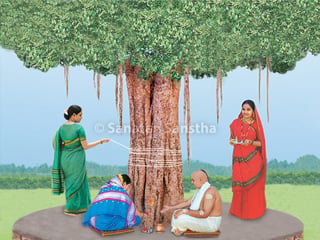
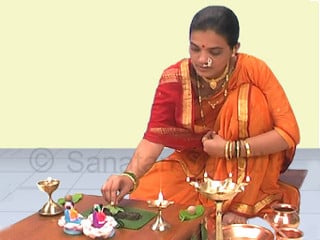 What is a vrat (Vowed religious observance)?
What is a vrat (Vowed religious observance)?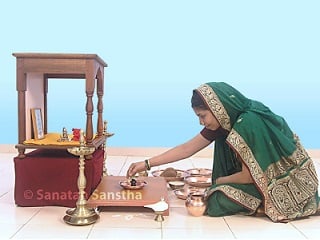 Importance and benefits of vrat (Vowed religious observances)
Importance and benefits of vrat (Vowed religious observances)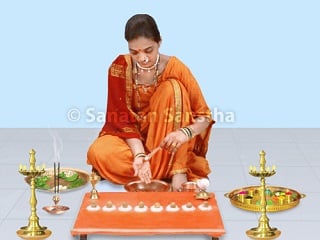 Types of vrats (Vowed religious observances)
Types of vrats (Vowed religious observances)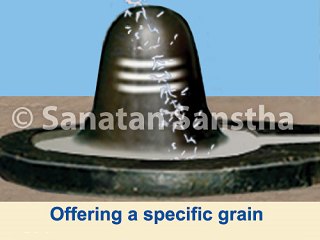 Vrat Rules to be followed by those undertaking Vrats
Vrat Rules to be followed by those undertaking Vrats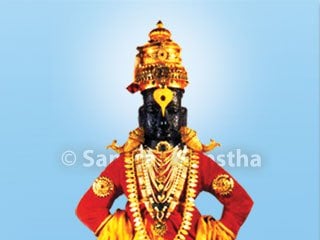 Ashadhi Ekadashi
Ashadhi Ekadashi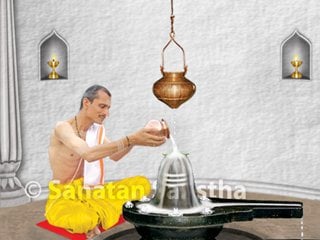 Shravan maas vrats and rituals
Shravan maas vrats and rituals